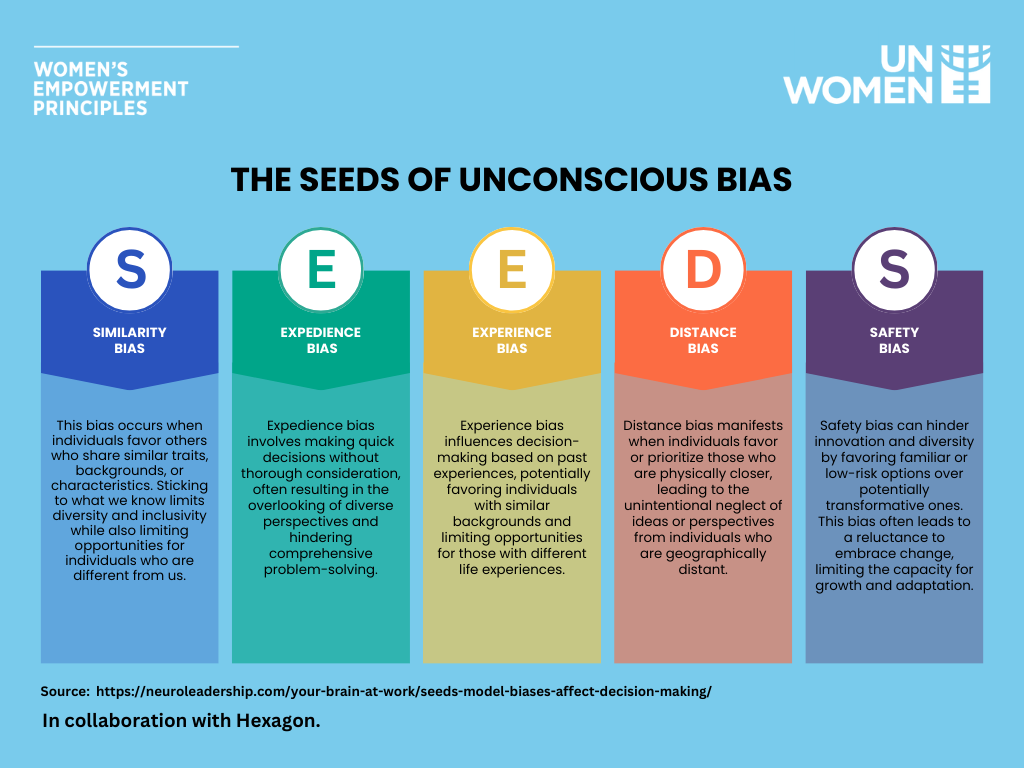“You are not responsible for your first thought, but you are responsible for your second thought and your first action. That is where your power lies,” said Nancy Rose, Senior Director of People and Culture at Hexagon, a WEPs signatory and global leader in clean energy solutions.
The WEPs team organized this event to demonstrate what unconscious bias is, where it appears, and how to address it. The objective was to raise awareness and provide participants with strategies to mitigate bias, fostering inclusive professional environments to drive positive change.
In the last 2023 WEPs deep-dive series on 5 December, the WEPs team invited Nancy to unpack the SEEDS of unconscious bias (Similarity, Expedience, Experience, Distance, and Safety) and how to mitigate them to implement mindful leadership practices.
What are the SEEDS of unconscious bias? [1]
“Bias is a mental shortcut that leads to judgment without question. Unconscious bias involves automatic associations without awareness, intention, or control. These associations often conflict with our conscious attitudes, behaviors, and intentions,” explained Nancy. Unconscious bias profoundly influences the workplace by shaping decisions, interactions, and opportunities. From hiring and promotions to everyday collaborations, these biases can inadvertently favor certain groups over others, perpetuating inequalities. In day-to-day interactions, unconscious bias can affect communication, team dynamics, and decision-making, fostering an environment where some voices are inadvertently prioritized while others are unheard.
Simple actions to make employees feel welcome and avoiding assumptions contribute to fostering an inclusive work environment. To achieve this, it is essential to think twice before acting to mitigate sending harmful micro-messages. Micro-messages are subtle but impactful signals that can reinforce stereotypes and contribute to an unequal workplace. Micro-inequities are subtle actions or comments that demean or marginalize individuals, while micro-aggressions involve negative actions targeting specific groups. Combatting these micro-messages involves the practice of micro-affirmations—small, positive words and acts that foster inclusion.
How does unconscious bias disrupt our efforts towards gender equality in the workplace?
For this last session of WEPs deep dives series in 2023, participants from more than 130 countries around the world joined from private sector, public sector and more. Throughout the session, participants actively engaged to share their perspectives of how unconscious bias could affect gender equality efforts in the workplace. Here are some key messages from the participants.
1. Unconscious biases perpetuate gender roles – limiting diversity and hindering equal opportunities.
From similarity bias influencing hiring decisions to expedience bias affecting promotions, these biases perpetuate gender roles, limiting diversity and hindering equal opportunities. Many participants shared that work-life balance is hindered by bias, with concerns about commitment due to motherhood, bias against working mothers, and assumptions about work hours impacting women’s career growth. Micro-messages in communication and inclusion further contribute to a hostile or unequal environment, with examples ranging from exclusion in meetings to assumptions about responsibilities based on gender.
Biases in decision-making processes, whether it is distance bias impacting opportunities or experience bias influencing promotions, are identified as hindrances to gender equality efforts. Networking and relationship biases, such as barriers for women and assumptions about responsibilities, contribute to limiting career growth for women and perpetuating gender-based stereotypes. Participants also mentioned the cultural and societal influences that introduce complexities, with expectations about gender roles and biases affecting hiring decisions based on cultural considerations.
2. Unconscious biases perpetuate negative gender-stereotypes.
Safety biases, such as fear of retaliation or making decisions based on perceived risks, can hinder diversity efforts and perpetuate negative stereotypes. Micro-affirmations and support in fostering a positive workplace culture can help counter this. Participants said that encouraging participation, recognizing achievements, and creating inclusive events contribute to an environment that values and supports everyone. Initiatives promoting equality and diversity, encompassing public policies and organizational efforts, are recognized as essential for fostering an inclusive workplace.
3. Unconscious biases can lead to a hostile and exclusive work environment.
In the realm of communication and inclusion, unconscious biases play a subtle yet potent role in shaping workplace dynamics. These covert signals, such as exclusion from meetings or assumptions about gender-based responsibilities, have a profound impact on the overall environment. They create a subtle undercurrent that contributes to a sense of hostility and inequality, hindering effective communication and inclusion efforts.
For instance, expedience bias may occur when quick decisions are made without considering diverse perspectives, leading to the unintentional exclusion of certain voices. In a fast-paced work environment, the desire for efficiency might result in overlooking valuable contributions from team members with different backgrounds or experiences. Distance bias can affect communication by favoring local team members over those working remotely. This bias may result in the unintentional neglect of ideas or insights from individuals geographically distant, hindering the organization's ability to tap into a wealth of diverse perspectives. Recognizing and addressing these biases is vital for fostering a truly inclusive and communicative workplace culture.
What can we do to make more inclusive workplace? – Mindful leadership
In navigating these multifaceted challenges, mindful leadership emerges as a crucial approach. Mindful leaders are attuned to biases, proactively address stereotypes, and foster an inclusive culture where diversity is embraced, and every voice is valued. By incorporating mindfulness into leadership practices, organizations can create an environment that not only recognizes and mitigates biases but also actively promotes gender equality in all aspects of the workplace.
Anyone can be a mindful leader – it doesn’t have to be the CEO or your manager. You can become a mindful leader by practicing micro-affirmations at work. The participants share their insights of examples of micro-affirmations from work that people could do. “Say hello!” Recognize one another’s presence, ideas, caring and giving opportunities to everyone in the table are some examples. To learn more on how to create a more mindful and equal workplace, check out the recording of our WEPs deep-dive series 3: Understanding Unconscious Bias.

